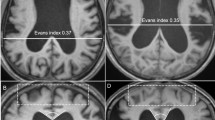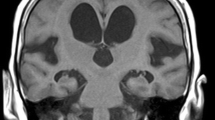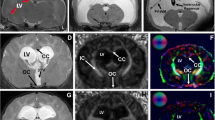Abstract
Background
Magnetic resonance images of children with hydrocephalus often include a rim of hyperintensity in the periventricular white matter (halo).
Objective
The purpose of this study was to decide between the hypothesis that the halo is caused by cerebrospinal fluid (CSF) flow during the cardiac cycle, and the alternate hypothesis that the halo is caused by anatomical changes (stretching and compression of white matter).
Materials and methods
Participants were selected from a multicenter imaging study of pediatric hydrocephalus. We compared 19 children with hydrocephalus to a group of 52 controls. We quantified ventricle enlargement using the frontal-occipital horn ratio. We conducted qualitative and quantitative analysis of diffusion tensor imaging in the corpus callosum and posterior limb of the internal capsule. Parameters included the fractional anisotropy (FA), mean diffusivity, axial diffusivity and radial diffusivity.
Results
The halo was seen in 16 of the 19 children with hydrocephalus but not in the controls. The corpus callosum of the hydrocephalus group demonstrated FA values that were significantly decreased from those in the control group (P = 4 · 10−6), and highly significant increases were seen in the mean diffusivity and radial diffusivity in the hydrocephalus group. In the posterior limb of the internal capsule the FA values of the hydrocephalus group were higher than those for the control group (P = 0.002), and higher values in the hydrocephalus group were also noted in the axial diffusivity. We noted correlations between the diffusion parameters and the frontal-occipital horn ratio.
Conclusion
Our results strongly support the hypothesis that the halo finding in hydrocephalus is caused by structural changes rather than pulsatile CSF flow.





Similar content being viewed by others
References
Persson EK, Anderson S, Wiklund LM et al (2007) Hydrocephalus in children born in 1999–2002: epidemiology, outcome and ophthalmological findings. Childs Nerv Syst 23:1111–1118
Wiswell T, Tuttle D, Northam R et al (1990) Major congenital neurologic malformations: a 17-year survey. Am J Dis Child 144:61–67
Gutiérrez-González R, Boto G, Pérez-Zamarrón A (2012) Cerebrospinal fluid diversion devices and infection. A comprehensive review. Eur J Clin Microbiol Infect Dis 31:889–897
Simon T, Riva-Cambrin J, Srivastava R et al (2008) Hospital care for children with hydrocephalus in the United States: utilization, charges, comorbidities, and deaths. J Neurosurg Pediatr 1:131–137
Notarianni C, Vannemreddy P, Caldito G et al (2009) Congenital hydrocephalus and ventriculoperitoneal shunts: influence of etiology and programmable shunts on revisions. J Neurosurg Pediatr 4:547–552
Dinçer A, Özek M (2011) Radiologic evaluation of pediatric hydrocephalus. Childs Nerv Syst 27:1543–1562
Bradley WG Jr (2001) Diagnostic tools in hydrocephalus. Neurosurg Clin N Am 12:661–684
Zimmerman R, Fleming C, Lee B et al (1986) Periventricular hyperintensity as seen by magnetic resonance: prevalence and significance. AJR Am J Roentgenol 146:443–450
Poncelet BP, Wedeen VJ, Weisskoff RM et al (1992) Brain parenchyma motion: measurement with cine echo-planar MR imaging. Radiology 185:645–651
Yuan W, Holland S, Shimony JS et al (2011) Quality assurance in multi-institution and multi-scanner MRI neuroimaging research. In: The 6th congress and exhibition of the Joint Societies of Paediatric Radiology, London, UK, May 27–31, 2011. http://www.ipr2011.org/documents/536.pdf. Accessed 9 Jan 2015
Jiang H, Mori S (2005) DTI-Studio version 2.40. Johns Hopkins University, Baltimore, MD. https://www.mristudio.org/. Accessed 9 Jan 2015
Basser PJ, Pierpaoli C (1998) A simplified method to measure the diffusion tensor from seven MR images. Magn Reson Med 39:928–934
Kulkarni AV, Drake JM, Armstrong DC et al (1999) Measurement of ventricular size: reliability of the frontal and occipital horn ratio compared to subjective assessment. Pediatr Neurosurg 31:65–70
Mukherjee P, Miller JH, Shimony JS et al (2002) Diffusion-tensor MR imaging of gray and white matter development during normal human brain maturation. AJNR Am J Neuroradiol 23:1445–1456
Bigio MD (2004) Cellular damage and prevention in childhood hydrocephalus. Brain Pathol 14:317–324
Tamnes C, Fjell A, Østby Y et al (2011) The brain dynamics of intellectual development: waxing and waning white and gray matter. Neuropsychologia 49:3605–3611
Klingberg T, Vaidya C, Gabrieli J et al (1999) Myelination and organization of the frontal white matter in children: a diffusion tensory MRI study. Neuroreport 10:2817–2821
Jones DK, Williams SC, Gasston D et al (2002) Isotropic resolution diffusion tensor imaging with whole brain acquisition in a clinically acceptable time. Hum Brain Mapp 15:216–230
Acknowledgments
This work was supported by an R01 NS066932 grant from the National Institutes of Health/National Institute of Neurological Disorders and Stroke (NIH/NINDS). The authors would like to acknowledge the critical efforts of the clinical research coordinators, Deanna Mercer and Sarah Simpson, and research assistant Akila Rajagopal.
Conflicts of interest
None
Author information
Authors and Affiliations
Corresponding author
Rights and permissions
About this article
Cite this article
Akbari, S.H.A., Limbrick, D.D., McKinstry, R.C. et al. Periventricular hyperintensity in children with hydrocephalus. Pediatr Radiol 45, 1189–1197 (2015). https://doi.org/10.1007/s00247-015-3298-8
Received:
Revised:
Accepted:
Published:
Issue Date:
DOI: https://doi.org/10.1007/s00247-015-3298-8




